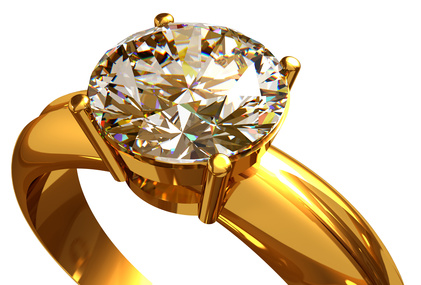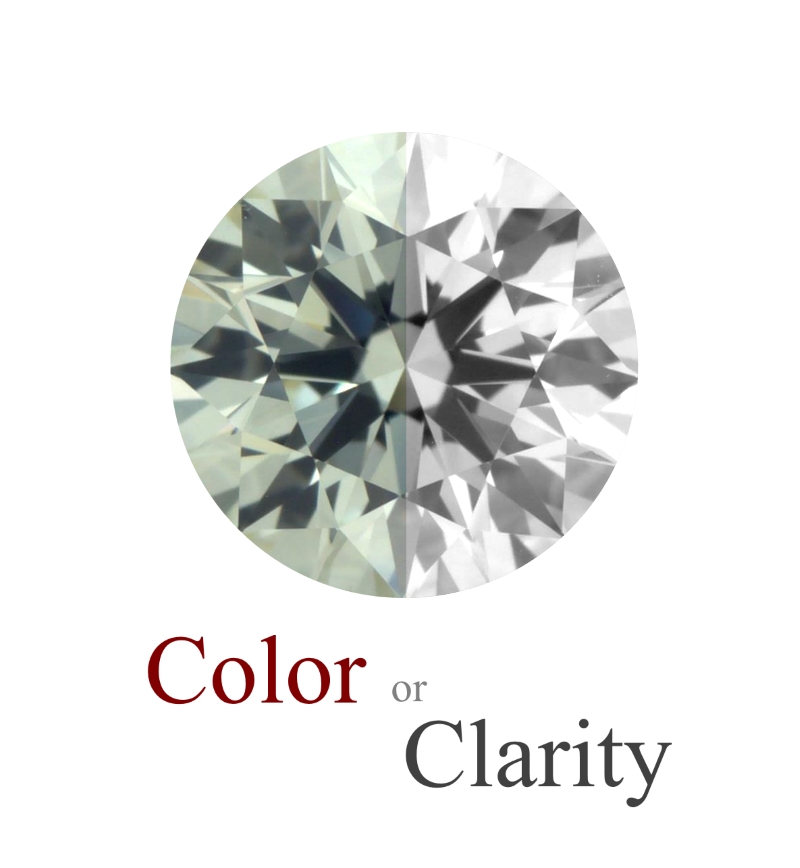How Diamond Color Is Graded
There are different color grading scales, but the most popular one is that of the G.I.A. (Gemological Institute of America).

If you are looking to buy a colorless diamond, you need to focus on the D-E-F color range.
On this scale, color is graded by using letters from D to Z. Take a look at what the different letter grades mean:
D, E, F – These diamonds are graded Colorless; there is little difference from one grade to the next, and the variation in color is not visible to the naked eye.
G, H, I, J – Stones graded with one of these letters are categorized as Near Colorless; they contain yellowish tints, but these hints of color are barely visible.
K, L, M – Diamonds in this group are graded Faint Yellow.
N to Z – Stones in this range are graded Very Light Yellow to Light Yellow; their color is easily seen, and they are cheaper.
Diamonds that have a very rich color are considered fancy-color diamonds and are not graded on this scale. Sometimes, such stones are referred to as being Z+ color grade.
The Most Affordable Colorless Diamonds
The less color a white diamond has, the more valuable it is considered.
If you are looking to buy a colorless diamond, you need to focus on the D-E-F range. Diamonds graded D have the best color; they are, however, very rare and expensive.
If you want to buy a colorless diamond and also save some money, go with the lower end of the range and get an F.
Check out a selection of F-color diamonds.
You can save a significant amount and you won’t need to worry about the color – the difference between D and F can be detected using precise color measurement tools, but it is virtually invisible to the naked eye.
How Important Is for a Diamond to Be Colorless?
Color is very important for the appearance of a diamond. Some even argue that it is the second most important factor for diamond beauty after cut.
Although experts can argue what the exact order of importance is, it would be useful for you to understand when color is important and when not so much.
Consider the following factors that determine the importance of color:
Cut
The extent to which a diamond’s color will affect the stone’s appearance depends on the proportions of its cut, which determines how light is bent and reflected by the diamond.
A more proportional cut will capture more light, and any color tints won’t be as visible as in a poorly cut stone.
Shape
A related factor is diamond shape: Some shapes tend to reflect light so as to make color hues more visible.
The appearance of the classic round cut is least affected by color because of the stone’s strong brilliance, whereas fancier shapes such as oval or radiant make any yellowish tints more prominent.
Setting
The color of the setting is also important for how visible the color of your diamond will be.
White settings, such as those made of platinum, will make any diamond whose color is darker look tinted because of the contrast.
Yellow gold settings, on the other hand, will make diamonds set in them stand out and look brighter.
Clarity
Generally, the more colorless a diamond, the brighter it will look and the less prominent any flaws within it will be.
What About Grades Lower Than Colorless?
Whether you will go with a colorless diamond or one that has some tint depends on your preferences and budget.
Keep in mind that if a diamond is nearly colorless, it may look exceptionally white when looked at in isolation, but the difference will be noticeable if you put it next to a colorless stone.
However, when wearing your diamond, you won’t be comparing it with other stones, so you shouldn’t be overly concerned about how perfect your diamond’s color is.
If you want to save even more money, you can get a Near Colorless diamond in the G-J range. As long as the stone is not large (less than 1 carat) it will look not much different from a technically colorless one.
How Colorless Should My Diamond Be?
When deciding how much down the grading scale you can go and still be happy with the color you get, consider these additional factors:
- The higher the carat of the diamond you are buying, the more important the color will be, as larger stones are more visible.
- If you are purchasing a Colorless or Near Colorless diamond, keep in mind that it’s best if the stone is set in a white metal (platinum, silver or white gold). Colored metals, such as yellow or rose gold, will spoil the colorless appearance of the diamond, and their reflections will make the stone look tinted with the metal’s original color.
- If you buy a diamond that has a faint or light hue, you shouldn’t have it set in a white metal because the stone’s color will stand out in the setting. Such diamonds are best mounted in colored metals. A K, L or M grade diamond set in yellow gold is a good choice if you are concerned about price.
- Keep in mind that even if your diamond is colorless, if its cut is poor, the stone’s brilliance will be lost. Always pay close attention to cut because its proportions are an important determinant of diamond sparkle. Don’t focus blindly on color.
Grade D
Diamonds graded D are very rare and expensive. It is rarely worth it to pay so much money for a color that most people cannot tell from a grade a couple of notches down.
If you are ready to pay the price, this is the best color to have, especially when set in platinum.
Grades E-F
The next two colorless grades, E and F, are a bit easier to find, but they are still relatively rare and expensive.
Consider them if money is no object and you need a colorless diamond that will be set in platinum or another white metal or alloy.
Grades G-H
Diamonds graded G and H fall in the Near Colorless range. These stones are a good alternative to the colorless variety – you will hardly be able to tell the difference, but they are significantly cheaper.
These grades are most suitable if you are buying a diamond that will be set in platinum or white gold, especially if the stone is cut in a fancy shape different from the round cut.
Grades I-J
Stones with grades I and J are at the bottom of the Near Colorless range. These diamonds display a very slight color that can be perceived with the naked eye only if the stone is put next to a much whiter object.
Diamonds of these colors are a good deal – they are even cheaper than G-H stones and you will still be able to put them in platinum or white gold as long as they have a round shape and a symmetrical cut.
Fancy shapes with these grades have more visible yellow tints, so you may want to have such stones set in yellow gold.
Grades K-L-M
Diamonds graded K, L and M have a faint yellow hue and for this reason, they are not suitable for white mountings.
These grades are a good choice if you need a diamond that you will have set in yellow gold.
There’s really no point in paying lots of money for a higher grade diamond as it won’t look much different from a K-L-M stone when put in a gold mounting – the yellow color of the metal will tint the diamond anyway.
The Naked Eye Factor
Whatever the color grade, you should see each diamond you are considering separately and decide whether it looks good to you as some people are more sensitive to color than others.
It is true that diamond color is graded by comparing stones to a benchmark, but since the diamond you choose will be worn in isolation, you should also evaluate its color in the same way.
Of course, if you are selecting a stone that will be set together with other diamonds, you should match colors.
And don’t forget that the differences between adjacent color grades are very subtle and hard to discern with the naked eye.
A Word About Certification and Color Ranges
Always ask if the diamond you are looking at is certified, preferably by the G.I.A. or a similarly reputable organization.
If there is no certificate, there is also no way for you to know the exact color grade of the stone, regardless of what the salesperson tells you.
Be wary if someone tries to sell you a diamond while referring to its color as a letter range and not an exact grade.
On the G.I.A. scale, color is graded with specific letters, and if the salesperson tells you that a diamond’s color grade is D-F or something similar, this most likely means that the seller doesn’t know what the exact color is.
Where to Buy Diamond Jewelry?
We recommend James Allen (read review) because you can see a 360-degree video for any diamond before buying it.
Blue Nile is another reputable diamond retailer we recommend.














